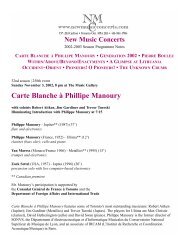2004-2005 Season The Hammerhead Consort - New Music Concerts
2004-2005 Season The Hammerhead Consort - New Music Concerts
2004-2005 Season The Hammerhead Consort - New Music Concerts
Create successful ePaper yourself
Turn your PDF publications into a flip-book with our unique Google optimized e-Paper software.
<strong>The</strong> term “Aeolian” (or eolian) can be used in association with the wind, or with an early church mode bearing<br />
the same name; the title Eolian Braid was chosen with reference to the former.<br />
Constructed especially for Eolian Braid, twenty-one sets of wind chimes were used to make a recorded<br />
accompaniment for use in live performance. Existing as a background layer characterized by diverse rhythms<br />
and timbres, the recorded chimes create the illusory presence of different winds that come and go almost<br />
unpredictably throughout the piece. <strong>The</strong> two pianos, vibraphone and marimba generate a foreground layer that,<br />
unlike the chimes, is a texture of controlled rhythmic processes involving repetition, pattern, phase and<br />
transformation. <strong>The</strong> complex counterpoint arising from the co-existing rhythmic strands within each of the two<br />
layers and the juxtaposition and intertwining of those layers on the larger level produce a textural counterpoint<br />
that, overall, might be described best as a rhythmic braid.<br />
While compositional techniques used in Eolian Braid might be traced to a range of sources, certain works by<br />
the composer György Ligeti stand as the most inspiring and influential.<br />
Malcolm Forsyth<br />
— Howard Bashaw<br />
Canadian composer Forsyth continues to enjoy a distinguished international career as a much-performed writer<br />
of more than one hundred-and-thirty works, including three symphonies, much other orchestral music,<br />
chamber music (especially for brass and strings), vocal and instrumental solos and more recently, choral<br />
music.<br />
He was named “Canadian Composer of the Year” by the Canadian <strong>Music</strong> Council in 1989, and has received<br />
many other awards, including three JUNOs for “Best Classical Composition” — 1987, 1994 and 1998 —<br />
since his arrival in Canada from his native South Africa in 1968. He took up his post as Professor at the<br />
University of Alberta in Edmonton in the same year and was for the last five years prior to his retirement in<br />
2002 Composer-in-Residence there. Distinguished performers such as Maureen Forrester, Charles Dutoit and<br />
Judith Forst have commissioned and premiered his works; his works have seen performances on six<br />
continents. A celebratory CD of his daughter Amanda’s performance of his Cello Concerto, Electra Rising, his<br />
saxophone concerto, Tre Vie, and Valley of a Thousand Hills, for chamber orchestra, was released in 1997, and<br />
one of Sun Songs, with Judith Forst (mezzo-soprano) in 2000. <strong>The</strong> years 1999 and 2000 were especially<br />
prolific ones for Forsyth, with no fewer than ten new works entering the catalogue. His Concerto for Eight<br />
(2003) received rave reviews after its many performances in March 2003. <strong>The</strong> Double Concerto, for viola,<br />
cello & orchestra, is scheduled for its world premiere in October <strong>2004</strong>.<br />
umGcomo (1999)<br />
When Béla Bartók wrote his monumental Sonata for Two Pianos and Percussion he spawned a new class of<br />
instrumental chamber music which has brought many new similar works into being. Ensembles have been<br />
formed simply with the intention of promoting the Bartók work and expanding the repertoire of its<br />
instrumentation. <strong>The</strong> <strong>Hammerhead</strong> <strong>Consort</strong> of Edmonton is one such group and umGcomo was written<br />
especially for it.<br />
<strong>The</strong> word umGcomo is Zulu, and means drums. Pronunciation of the word, however, is almost impossible for<br />
most people, since the ‘gc’ consonant is one of the “click” sounds found in Zulu and several other South<br />
African languages. Rendering it, as is common, as a “k” does not suffice here though, since that would turn




